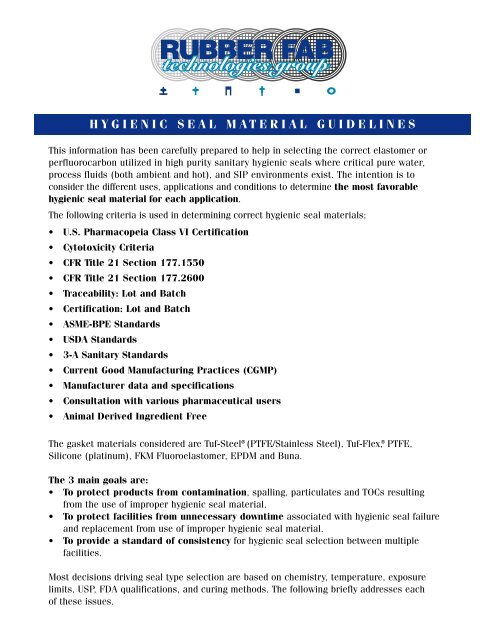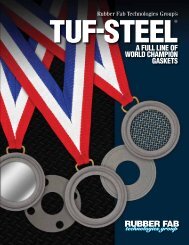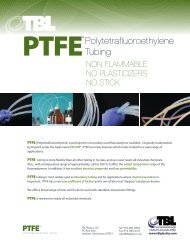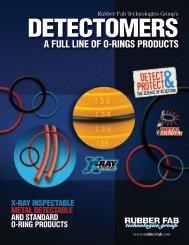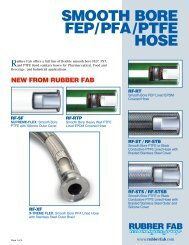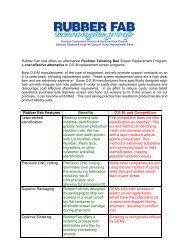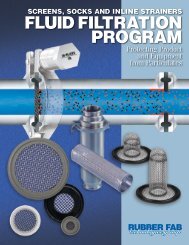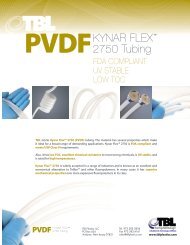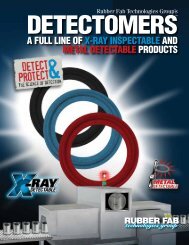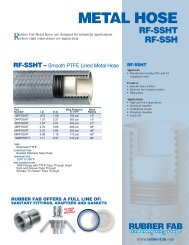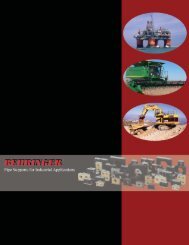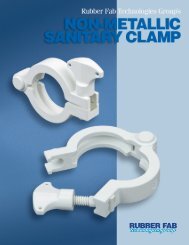HYGIENIC SEAL MATERIAL GUIDELINES
HYGIENIC SEAL MATERIAL GUIDELINES
HYGIENIC SEAL MATERIAL GUIDELINES
Create successful ePaper yourself
Turn your PDF publications into a flip-book with our unique Google optimized e-Paper software.
<strong>HYGIENIC</strong> <strong>SEAL</strong> <strong>MATERIAL</strong> <strong>GUIDELINES</strong><br />
This information has been carefully prepared to help in selecting the correct elastomer or<br />
perfluorocarbon utilized in high purity sanitary hygienic seals where critical pure water,<br />
process fluids (both ambient and hot), and SIP environments exist. The intention is to<br />
consider the different uses, applications and conditions to determine the most favorable<br />
hygienic seal material for each application.<br />
The following criteria is used in determining correct hygienic seal materials;<br />
• U.S. Pharmacopeia Class VI Certification<br />
• Cytotoxicity Criteria<br />
• CFR Title 21 Section 177.1550<br />
• CFR Title 21 Section 177.2600<br />
• Traceability: Lot and Batch<br />
• Certification: Lot and Batch<br />
• ASME-BPE Standards<br />
• USDA Standards<br />
• 3-A Sanitary Standards<br />
• Current Good Manufacturing Practices (CGMP)<br />
• Manufacturer data and specifications<br />
• Consultation with various pharmaceutical users<br />
• Animal Derived Ingredient Free<br />
The gasket materials considered are Tuf-Steel ® (PTFE/Stainless Steel), Tuf-Flex, ® PTFE,<br />
Silicone (platinum), FKM Fluoroelastomer, EPDM and Buna.<br />
The 3 main goals are:<br />
• To protect products from contamination, spalling, particulates and TOCs resulting<br />
from the use of improper hygienic seal material.<br />
• To protect facilities from unnecessary downtime associated with hygienic seal failure<br />
and replacement from use of improper hygienic seal material.<br />
• To provide a standard of consistency for hygienic seal selection between multiple<br />
facilities.<br />
Most decisions driving seal type selection are based on chemistry, temperature, exposure<br />
limits, USP, FDA qualifications, and curing methods. The following briefly addresses each<br />
of these issues.
<strong>HYGIENIC</strong> <strong>SEAL</strong> <strong>MATERIAL</strong> <strong>GUIDELINES</strong><br />
Exposure Limits<br />
It is important to define the operating parameters of a new or existing processing sanitary<br />
system. The user specifications for exposure limits and reactivity to process fluids are compared<br />
with process operating parameters. All materials are acceptable for steam excluding Buna.<br />
All materials should meet process fluid reactivity parameters. Even though all compound<br />
exposure limits fall within operating parameters, the service life of some compounds will be<br />
different under certain conditions. This must be considered when selecting a compound.<br />
FDA and USP Qualifications<br />
CFR’s define the criteria for extractables and for compounds used in the manufacture of rubber<br />
and plastic articles. The two applicable categories are; rubber articles (Buna, EPDM, FKM<br />
Fluoroelastomer, Silicone) and perfluorocarbon resins (PTFE).<br />
USP defines the criteria for testing biological reactivity and the amount/type of extractables.<br />
The hygienic seals in service must meet USP Class VI specifications, and be manufactured<br />
using the proper compounds as stated in the CFR, Title 21, Sections 177.1550 and 177.2600<br />
respectively. Certificates are available from Rubber Fab Technologies Group verifying compliance<br />
with regulatory requirements, traceability lot and batch and certification lot and batch.<br />
Note: Not all hygienic seals meet these requirements.<br />
Curing Methods<br />
Curing agents have an affect on the amount and type of extractables a material will emit.<br />
Typically, the hygienic seal group in service uses three methods; sulfur cured*, peroxide cured<br />
and platinum cured. When dealing with elastomers, peroxide cured is the most favorable<br />
method. When dealing with silicone, platinum cured is the most favorable. All gaskets shall<br />
be post cured. Using these methods minimize potential reactions with the respective process<br />
fluid applications and can uphold pure water and process fluid standards.<br />
* Sulfur cured elastomers can significantly alter a process fluids integrity and negatively<br />
affect mammalian cell yields.<br />
Note hygienic seal identification for curing methods. For example, EPDM: one green dot (• )<br />
means sulfur cured and three green dots (•••) means peroxide cured.<br />
RUBBER FAB EPDM <strong>HYGIENIC</strong> <strong>SEAL</strong>S ARE ALL PEROXIDE CURED.<br />
What Material(s) Can Be Used<br />
By reviewing manufacturer data and compiling information regarding regulatory requirements,<br />
it appears that any of the aforementioned compounds are suitable for both utility and process<br />
equipment use. However, you must ensure that all hygienic seals and compounds meet the<br />
CFR and USP requirements, and have a certificate to verify compliance.
<strong>HYGIENIC</strong> <strong>SEAL</strong> <strong>MATERIAL</strong> <strong>GUIDELINES</strong><br />
What Material(s) Should Be Used<br />
• Tuf-Steel ® is the material of choice when purity, long service life performance, chemical<br />
and heat resistance is required. Leak free when torqued correctly. Minimum creep and<br />
cold flow. Non-stick, ultra-low absorption and no pigmentation. Maintains seal integrity in<br />
applications where large temperature variations occur frequently. It can remain in service<br />
for extended periods of time in both water and frequent SIP use. The Torque-Rite ® is<br />
recommended for use with clamps (See Torque-Rite literature for complete details).<br />
• PTFE is the material of choice whenever low temperature flexibility or hygienic seal memory<br />
is not required (not recommended where large temperature variations occur frequently,<br />
leakage can occur). PTFE has almost no extractables, has a low absorption rate and<br />
excellent resistance to process fluids. It can remain in service for longer periods of time<br />
in both water and steam for continuous use, high pressure clamps are recommended to<br />
prevent leakage resulting from temperature variations. A PTFE envelope hygienic seal with<br />
an FKM Fluoroelastomer inner core should be used if slight misalignment is observed.<br />
• Platinum cured silicone is the material of choice in sanitary water systems when PTFE is<br />
not feasible due to severely misaligned fittings, or if the cost of high pressure clamps does<br />
not outweigh the benefits of PTFE (extended service life).<br />
• FKM Fluoroelastomer, EPDM and Buna compounds are specified by many of our process<br />
equipment manufacturers. They are generally suitable for these applications, however,<br />
service life must be considered and a preventative maintenance program be implemented<br />
to mitigate degradation. They are not recommended for continuous use in SIP procedures.<br />
• Color coding - identification of hygienic seal materials<br />
material description color code<br />
Tuf-Steel ®<br />
no dot<br />
Tuf-Flex ®<br />
no dot<br />
PTFE<br />
no dot<br />
PTFE Type 3 envelope seals<br />
FKM Fluoroelastomer filler one white, one yellow dot<br />
EPDM filler three green dots<br />
••<br />
•••<br />
FKM Fluoroelastomer one white, one yellow dot ••<br />
EPDM*<br />
sulfur cured one green dot<br />
peroxide cured* three green dots<br />
•<br />
•••<br />
Silicone<br />
peroxide cured one pink dot •<br />
platinum cured<br />
no dot<br />
Buna one red dot •<br />
* All Rubber Fab EPDM hygienic seals are peroxide cured.
<strong>HYGIENIC</strong> <strong>SEAL</strong> <strong>MATERIAL</strong> <strong>GUIDELINES</strong><br />
1 = Excellent 2 = Good 3 = Acceptable 4 = Marginal 5 = Poor X = Do Not Use<br />
Gasket Continuous Intermittent Pure Pure Process Process Process Temp.<br />
Stream Steam Water Water Fluids Fluids Fluids Variable Range<br />
Comments Ambient Hot Ambient Hot (100’C)<br />
Tuf-Steel ® 1 1 1 1 1 1 1 -100°F to<br />
Maintains seal with wide temperature variations. Has extended service life.* 500°F<br />
Tuf-Flex ® 1 1 1 1 1 1 1 -100°F to<br />
Maintains seal with wide temperature variations. Has extended service life.* 350°F<br />
PTFE 1 1 1 1 1 1 3 -100°F to<br />
Wide temperature variations and may cause leakage at ∆T. 500°F<br />
Silicone (platinum) 2 2 2 2 2 2 1 -40°F to<br />
Very flexible low temperature. 450°F<br />
FKM Fluoroelastomer 3 2 2 2 2 2 2 -30°F to<br />
Acceptable for steam applications. 400°F<br />
EPDM (peroxide cured) 3 3 3 3 3 3 3 -30°F to<br />
Low pressure steam only. 300 °F<br />
Buna 0 0 5 5 5 5 5 -30°F to<br />
Not recommended for strong acids and ozone. 200°F<br />
* Application dependent.<br />
• Tuf-Flex ® : Tuf-Flex is the world’s only<br />
unitized gasket, setting new standards<br />
for purity, performance and flexibility.<br />
A Tuf-Flex Gasket’s contact surface is<br />
a layer of PTFE unitized to an EPDM<br />
rubber inner core. This totally bonded<br />
construction provides a PTFE gasket with<br />
the mechanical characteristics, including<br />
memory, of an elastomer gasket. Designed<br />
to meet critical requirements in biopharmaceutical,<br />
ultra-pure water, WFI<br />
(water for injection) and difficult food<br />
and beverage processing, Tuf-Flex<br />
out performs other gaskets while<br />
eliminating costly process interruptions.<br />
Achieve higher performance under<br />
SIP/CIP conditions.<br />
• Tuf-Steel ® : A unique 50/50 blend of nonpigmented<br />
PTFE and 316L, water atomized<br />
and passivated, delivers leak-proof<br />
performance. Tuf-Steel is the choice for<br />
leak-proof, perfect surface performance<br />
and outstanding durability in SIP<br />
(steam in place) and WFI (water for<br />
injection) applications. Tuf-Steel is ideal<br />
for sanitary steam pipe connections<br />
in extreme temperatures ranging from<br />
-20°F to 500°F. The superior strength<br />
of Tuf-Steel eliminates cold flow and<br />
creep to prevent maintenance problems<br />
and system downtime.<br />
• PTFE is the material of choice whenever<br />
low temperature flexibility or gasket<br />
memory is not required (not recommended<br />
where large temperature variations occur<br />
frequently, leakage can occur). PTFE<br />
has almost no extractables, has a low<br />
absorption rate and excellent resistance<br />
to process fluids. It can remain in service<br />
for longer periods of time in both water<br />
and steam for continuous use, high pressure<br />
clamps are recommended to prevent<br />
leakage resulting from temperature variations.<br />
PTFE envelope gaskets with a FKM<br />
Fluoroelastomer inner core should be<br />
used if slight misalignment is observed.<br />
• Platinum Cured Silicone is the material<br />
of choice in sanitary water systems when<br />
PTFE is not feasible due to severely<br />
misaligned fittings, or if the cost of high<br />
pressure clamps does not outweigh the<br />
benefits of PTFE (extended service life).<br />
• FKM Fluoroelastomer and EPDM compounds<br />
are specified by many of our<br />
process equipment manufacturers. They<br />
are generally suitable for these applications,<br />
however, service life must be considered<br />
and a preventative maintenance program<br />
be implemented to mitigate degradation.<br />
They are acceptable, but not recommended<br />
for continuous use in SIP procedures.<br />
• Buna is the last choice in most applications<br />
due to temperature limitations and<br />
does not pass U.S. Pharmacopeia<br />
Class VI Certification and Cytotoxicity.<br />
This sheet indicates general preferences.<br />
Unique applications may require further<br />
considerations and analysis. When selecting<br />
hygienic seal materials it is important<br />
to consider many factors: resistance to<br />
heat, resistance to SIP, resistance to chemicals<br />
like; hydrocarbons, ethanol, ketones,<br />
etc, tear strength, and flexibility. The<br />
service life of a material depends on<br />
the application. Many of the materials are<br />
acceptable if the expected service life is<br />
very short in duration, however, in extended<br />
exposure situations the material can<br />
degrade quickly rendering it ineffective or<br />
less desirable overall. This analysis was<br />
intended for hygienic seal applications<br />
specifically. Sanitary gasket applications<br />
are inherently static and can be dynamic.<br />
When different performance attributes are<br />
a consideration in dynamic applications,<br />
Tuf-Steel may be the material of choice.<br />
® Torque-Rite, Tuf-Flex, Tuf-Steel and ADI Free<br />
are registered trademarks of Rubber Fab<br />
Technologies Group.<br />
Torque-Rite: United States Patent Number 6,082,941.<br />
©2004 Rubber Fab Technologies Group – rev. 8/05 – #RF-140


